python基础4 函数参数引用 python内置函数 filter map open处理文件
一 作业点回顾
1 判断对象是否属于某个类 对应题:比如 列表有个数字,但是循环列表就判断长度,用len 会报错。 因为int不支持len ,所以先判断 属于某类,再进行if判断。
# isinstance(对象,类名) 判断变量输入的对象是否是属于这个类 # 方法1: temp = [11, 22, "", " ", []] print(isinstance(temp, (str, list, tuple))) # 一旦对象属于这个后面元组的类中的任何一个 就返回true # 方法2: a = type(temp) is list print(a)
二 函数 参数引用 知识点
写在前面:
python中 函数传参,传引用 ,形参其实是指针映射到 实际参数的的内存地址中的。一旦更改形参对应的值,实际参数也会改。
而 java c# 是可以改的,形参 实际参数都 生成一份数据 ,这个功能要想完成只需在 形参处 加一个ref out /再创建一份值
python 函数形参 是指针向实际参数的。
python中 直接 copy一份就行
函数参数 引用 1 :修改 或删除形参的 值 ,实际参数值也变化
函数调用,而实际参数传入的是一个列表, 这样就是 形式参数args = 实际参数li = [1,2] 由下图表示
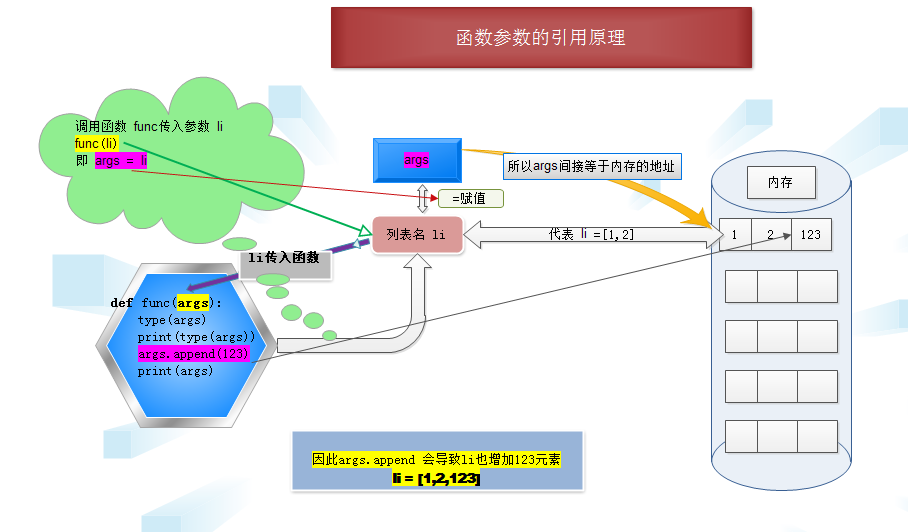
def func(args): type(args) print(type(args)) args.append(123) print(args) li = [1, 2] func(li) print(li)
删除 也删除 其实 li = [] args=li 原理一样 def func(args): del args[2:] li=[1,2,3,4] a=func(li) print(li) #结果[1, 2]
函数 参数引用2 : 形式参数 赋值 另开辟内存
尽管 传入实际参数 li 使得 args =li ,但是 函数主体 args=123 重新赋值 相当于args重新开辟了一段 内存空间,而原li还是原来的值 如果是同一个变量名 重新赋值,原来占用内存的那个 变量空间 python会定时回收

赋值 尽管 函数调用时候 args=li 但是重新赋值,等于申请了新的内存空间。 def func(args): args=123 li=[1,2,3,4] a=func(li) print(li) #结果 [1,2,3,4]
三 lambda 匿名函数
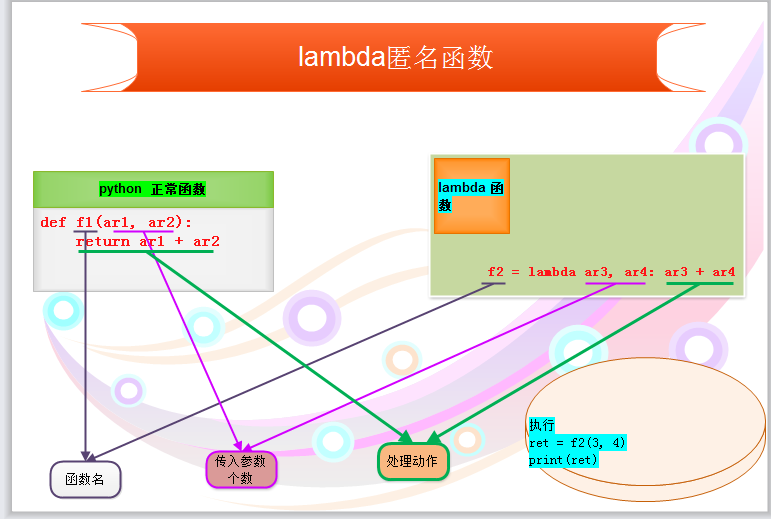
# lambda 匿名函数 def f1(ar1, ar2): return ar1 + ar2 f2 = lambda ar3, ar4: ar3 + ar4 ret = f2(3, 4) print(ret)
学习条件运算时,对于简单的 if else 语句,可以使用三元运算来表示,即:
1 # 普通条件语句 2 if 1 == 1: 3 name = 'wupeiqi' 4 else: 5 name = 'alex' 6 7 # 三元运算 8 name = 'wupeiqi' if 1 == 1 else 'alex'
对于简单的函数,也存在一种简便的表示方式,即:lambda表达式
1 # ###################### 普通函数 ###################### 2 # 定义函数(普通方式) 3 def func(arg): 4 return arg + 1 5 6 # 执行函数 7 result = func(123) 8 9 # ###################### lambda ###################### 10 11 # 定义函数(lambda表达式) 12 my_lambda = lambda arg : arg + 1 13 14 # 执行函数 15 result = my_lambda(123)
四 python的内置函数
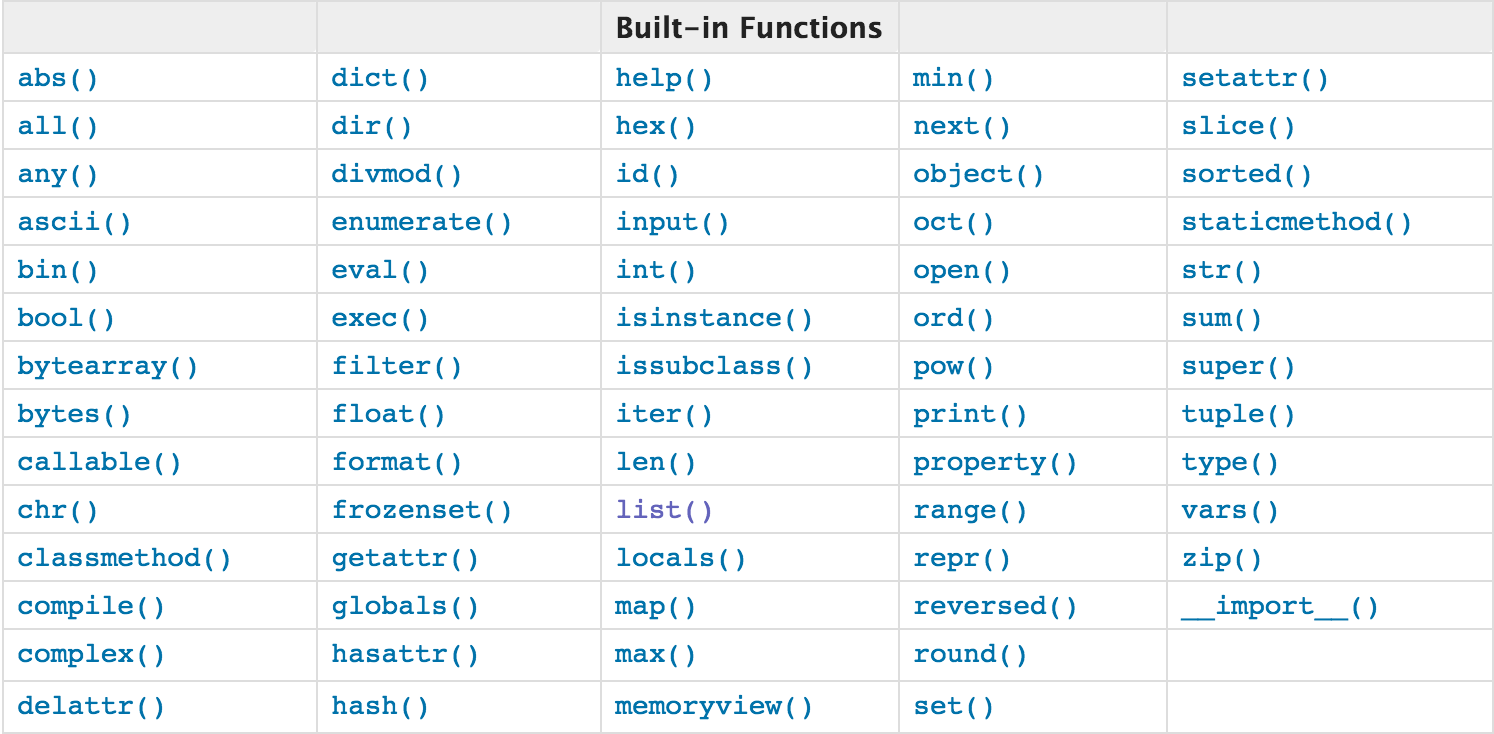
注:查看详细猛击这里
1 大部分函数
abs()返回一个数字的绝对值。如果给出复数,返回值就是该复数的模。
>>>print abs(-100) 100 >>>print abs(1+2j) 2.2360679775
1 # 内置函数: 2 # 1 abs() 绝对值 3 a = 123 4 b = -123 5 print(abs(a)) 6 print(abs(b))
all() 所有为真才为真,只要有一个假就是假
判断假的条件:
任何一种都为假: 0 None 空值(字符串 列表 元组 字典)
li = [1, 2, 3, "", False] print(all(li))
any() 一个为真就为真 同all相反,只有有真就返回True 真: 非0 非None 非空
1 li = [1, 2, 3, "", False] 2 print(any(li))
ascii() 用法:ascii(对象) ===去类中找 __repr__ 方法,获取返回值
1 class Foo(object): 2 def __repr__(self): 3 return "hello repr" 4 5 6 li = Foo() 7 n = ascii(li) 8 print(n)
bin oct int hex 二进制 八进制 十进制 十六进制
1 # bin() 可以将 八 十 十六 进制 转换成二进制 2 print(bin(10), bin(0o13), bin(0x14)) 3 # oct() 可以将 二 十 十六 进制 转换为八进制 4 print(oct(10), oct(0b101), oct(0x14)) 5 # int() 可以将 二 八 十六进制转换为十进制 6 print(int(0o13), int(0b101), int(0x14)) 7 # hex() 可以将 二 八 十 进制转换为十六进制 8 print(hex(0b101), hex(110), hex(0o12))
bool 判断真假
看到上面的结果了没?是True。突然记起Python中除了''、""、0、()、[]、{}、None为False之外,其他的都是True。也就是说上面的'False'就是一个不为空的字符串,所以结果就为True了
1 >>> bool('False') 2 True
将一个值转化成布尔值,使用标准的真值测试例程。如果x为假或者被忽略它返回False;否则它返回True。bool也是一个类,它是int的子类。bool不能被继承。它唯一的实例就是False和True。
# 7 bytes bytearray 字节列表
byte在前面已经介绍过了 bytes('str',encoding='')
bytearray([source[, encoding[, errors]]])
1 返回一个新的字节数组。bytearray类型是一个可变的整数序列,整数范围为0 <= x < 256(即字节)。 它有可变序列的大多数方法,参见Mutable Sequence Types,同时它也有str类型的大多数方法,参见String Methods。 2 3 source参数可以以不同的方式来初始化数组,它是可选的: 4 5 如果是string,必须指明encoding(以及可选的errors)参数;bytearray()使用str.encode()将字符串转化为字节数组。 6 如果是integer,生成相应大小的数组,元素初始化为空字节。 7 如果是遵循buffer接口的对象,对象的只读buffer被用来初始化字节数组。 8 如果是iterable,它的元素必须是整数,其取值范围为0 <= x < 256,用以初始化字节数组。 9 如果没有参数,它创建一个大小为0的数组。
>>> a = bytearray(3) >>> a bytearray(b'\x00\x00\x00') >>> a[0] >>> a[1] >>> a[2] >>> b = bytearray("abc") >>> b bytearray(b'abc') >>> b[0] >>> b[1] >>> b[2] >>> c = bytearray([1, 2, 3]) >>> c bytearray(b'\x01\x02\x03') >>> c[0] >>> c[1] >>> c[2] >>> d = bytearray(buffer("abc")) >>> d bytearray(b'abc') >>> d[0] >>> d[1] >>> d[2]
chr ord 转换 ascii对应的字符与十进制整数转换 可以百度 ascii 对照表
返回一个单字符字符串,字符的ASCII码为整数i。例如,chr(97)返回字符串'a'。 它是ord()的逆运算。参数的取值范围为[0..255]的闭区间;如果i超出取值范围,抛出ValueError。参见unichr()。
1 c = chr(65) 2 i = ord("A") 3 print(c, i)
打印 字母 数字
# 随机验证码 程序: # 65 -90 A - Z # 而 random.randrange(num1,num2) 大于等于num1 小于num2 的随机数 import random tmp = "" for i in range(6): num = random.randrange(0, 4) # 0-3 随机 if num == 2 or num == 3: # 随机数字时候 赋值随机数字 rad1 = random.randrange(0, 9) rad1 = str(rad1) #转换字符串 tmp += rad1 #字符串拼接 else: rad2 = random.randrange(65, 91) rad2 = chr(rad2) tmp += rad2 print("本次验证码:", tmp)
我自己写的验证码 数字 大小写字母
import random
print(random.random())
print(random.randint(1, 2)) # 返回列表的值[1,2] 因此 start 和end 都能访问到
'''
def randint(self, a, b):
"""Return random integer in range [a, b], including both end points.
"""
return self.randrange(a, b+1)
'''
print(random.randrange(1, 10)) # randrange(self, start, stop=None, step=1, _int=int)
temp =""
flag = 1
for i in range(6):
num = random.randint(65,90)
for n in range(4):
if len(temp) >= 6:
flag = 0
break
x = random.randint(0,9)
if x < n:
temp += str(x)
elif x == n:
#temp += chr(num).swapcase() # 大写变小写,小写变大写到
temp += chr(num).lower() # 大写变小写,小写变大写到
if len(temp) >= 6:
flag = 0
break
if flag == 0:
break
temp += chr(num)
print(temp)
callable(object)
检查某个对象是否可以被执行 即 对象()
如果object参数可调用,返回True;否则返回False。如果返回真,对其调用仍有可能失败;但是如果返回假,对object的调用总是失败。注意类是可调用的(对类调用返回一个新实例);如果类实例有__call__()方法,则它们也是可调用的。
# 10 classmethod 后面讲 重要
# 11 compile 编译 默认读文件都是字符串,经过编译变成代码
#!usr/bin/env python #coding:utf-8 namespace = {'name':'wupeiqi','data':[18,73,84]} code = '''def hellocute():return "name %s ,age %d" %(name,data[0],) ''' func = compile(code, '<string>', "exec") exec func in namespace result = namespace['hellocute']() print result
hasattr getattr delattr 反射 后面单独讲
# hasattr() getattr() delattr() # >>> hasattr(list, 'append') # True # >>> hasattr(list, 'add') # False
# 12 complex 复数
创建一个复数,它的值为real + imag*j;或者将一个字符串/数字转化成一个复数。如果第一个参数是个字符串,它将被解释成复数,同时函数不能有第二个参数。
第二个参数不能是字符串。每个参数必须是数值类型(包括复数)。如果imag被忽略,它的默认值是0,这时该函数就像是int(),long()和float()这样的数值转换函数。
如果两个参数都被忽略,返回0j。 注意 当从字符串转化成复数的时候,字符串中+或者-两边不能有空白。例如,complex('1+2j')是可行的,但complex('1 + 2j')会抛出ValueError异常。 在Numeric Types — int, float, long, complex中有对复数的描述。
# dir 显示类的方法
如果没有参数,返回当前本地作用域内的名字列表。如果有参数,尝试返回参数所指明对象的合法属性的列表。
如果对象有__dir__()方法,该方法被调用且必须返回一个属性列表。这允许实现了定制化的__getattr__()或者__getattribute__()函数的对象定制dir()报告对象属性的方式。
如果对象没有提供__dir__(),同时如果对象有定义__dict__属性,dir()会先尝试从__dict__属性中收集信息,然后是对象的类型对象。结果列表没有必要是完整的,如果对象有定制化的__getattr__(),结果还有可能是不准确的。
对于不同类型的对象,默认的dir()行为也不同,因为它尝试产生相关的而不是完整的信息:
- 如果对象是模块对象,列表包含模块的属性名。
- 如果对象是类型或者类对象,列表包含类的属性名,及它的基类的属性名。
- 否则,列表包含对象的属性名,它的类的属性名和类的基类的属性名。
返回的列表按字母顺序排序。例如:
1 >>> import struct 2 >>> dir() # show the names in the module namespace 3 ['__builtins__', '__doc__', '__name__', 'struct'] 4 >>> dir(struct) # show the names in the struct module 5 ['Struct', '__builtins__', '__doc__', '__file__', '__name__', 6 '__package__', '_clearcache', 'calcsize', 'error', 'pack', 'pack_into', 7 'unpack', 'unpack_from'] 8 >>> class Shape(object): 9 def __dir__(self): 10 return ['area', 'perimeter', 'location'] 11 >>> s = Shape() 12 >>> dir(s) 13 ['area', 'perimeter', 'location']
注意
因为dir()主要是为了在交互式环境下使用方便,它尝试提供有意义的名字的集合,而不是提供严格或一致定义的名字的集合,且在不同的版本中,具体的行为也有所变化。例如,如果参数是一个类,那么元类属性就不会出现在结果中。
# 14 divmod(10,3) 显示商和余数
# 分页 :余数大于0 商+1 为页数
在长整数除法中,传入两个数字(非复数)作为参数,返回商和余数的二元组。
对于混合的操作数类型,应用二元算术运算符的规则。对于普通整数或者长整数,结果等同于(a // b, a % b)。对于浮点数结果是(q, a % b),q一般是math.floor(a / b),但也可能比那小1。
不管怎样,q * b + a % b非常接近于a,如果a % b非0,它和b符号相同且0 <= abs(a % b) < abs(b)。
# 15 enumerate 序列
enumerate(sequence, start=0)
返回一个枚举对象。sequence必须是个序列,迭代器iterator,或者支持迭代的对象。enumerate()返回的迭代器的next()方法返回一个元组,它包含一个计数(从start开始,默认为0)和从sequence中迭代得到的值:
1 >>> seasons = ['Spring', 'Summer', 'Fall', 'Winter'] 2 >>> list(enumerate(seasons)) 3 [(0, 'Spring'), (1, 'Summer'), (2, 'Fall'), (3, 'Winter')] 4 >>> list(enumerate(seasons, start=1)) 5 [(1, 'Spring'), (2, 'Summer'), (3, 'Fall'), (4, 'Winter')]
等同于:
def enumerate(sequence, start=0): n = start for elem in sequence: yield n, elem n += 1
# 16 eval # 字符串 转算 执行表达式 有返回值
eval(expression[, globals[, locals]])
参数是Unicode或者Latin-1编码的字符串,全局变量和局部变量可选。如果有全局变量,globals必须是个字典。如果有局部变量,locals可以是任何映射类型对象。
改变于版本2.4:在此之前locals需要是个字典。
expression参数被当作Python表达式来解析并演算(技术上来说,是个条件列表),使用globals和locals字典作为全局和局部的命名空间。如果globals字典存在,且缺少‘__builtins__’,在expression被解析之前,当前的全局变量被拷贝进globals。这意味着一般来说expression能完全访问标准__builtin__模块,且受限的环境会传播。如果locals字典被忽略,默认是globals字典。如果都被忽略,表达式在eval()被调用的环境中执行。返回值是被演算的表达式的结果。语法错误报告成异常。例子:
>>> x = 1 >>> print eval('x+1') 2
a = "1 + 3"
n = eval(a)
print(n)
ret = eval("a+60", {"a": 88})
print(ret)
该函数也能执行任意的代码对象(如compile()返回的结果)。 在这种情况下,传递代码对象而不是字符串。如果代码对象编译时mode参数为'exec',eval()返回None。
提示:exec语句支持动态的语句执行。execfile()函数支持执行文件中的语句。globals()和locals()函数返回当前的全局变量和局部变量的字典,可以传递给eval()或者execfile()。
参见ast.literal_eval(),该函数能安全演算只含字面量的表达式的字符串。
# 17 exec 将字符串 执行 complie 编译功能 结合是 模板引擎
exec("for i in range(3):print(i)")
# 18 filter map reduce # filter(函数,可迭代的对象)
1 def f1(x): 2 if x >22: 3 return True 4 else: 5 return False 6 ret = filter(f1,[11,22,33]) 7 # 默认处理结果返回是一个类,需要迭代打印,因为浪费内存。 可以用next迭代取值。 或者for循环 循环依次取出 8 print(next(ret))
print(list(ret))
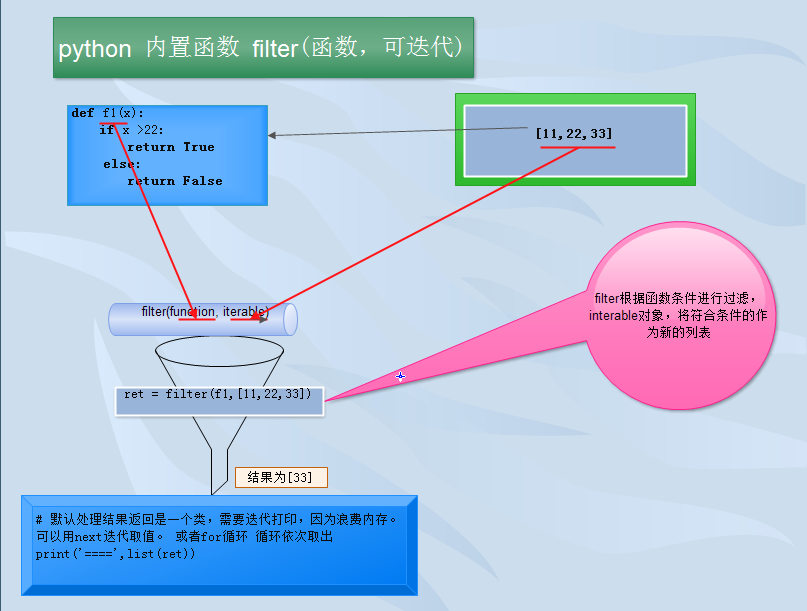
1 #filter 实现 2 def myfilter(fuc,seq): 3 new_li = [] 4 for i in seq: 5 #print(i) 6 ret = fuc(i) 7 if ret: 8 new_li.append(i) 9 return new_li 10 def f1(x): 11 if x > 22: 12 return True 13 else: 14 return False 15 li = [11,22,33,44] 16 new=myfilter(f1,li) 17 print(new)
filter(function, iterable)
构造一个列表,列表的元素来自于iterable,对于这些元素function返回真。iterable可以是个序列,支持迭代的容器,或者一个迭代器。如果iterable是个字符串或者元组,则结果也是字符串或者元组;否则结果总是列表。如果function是None,使用特性函数,即为假的iterable被移除。
注意,在function不为None的情况下, filter(function, iterable) 等同于 [item for item in iterable if function(item)]; 否则等同于 [item foritem in iterable if item](function为None)。
# filter中 lambda 函数替换 函数f1
1 ret1 = filter(lambda x:x>22,[11,22,33,44]) 2 print(list(ret1))
# map map(函数,可迭代的对象
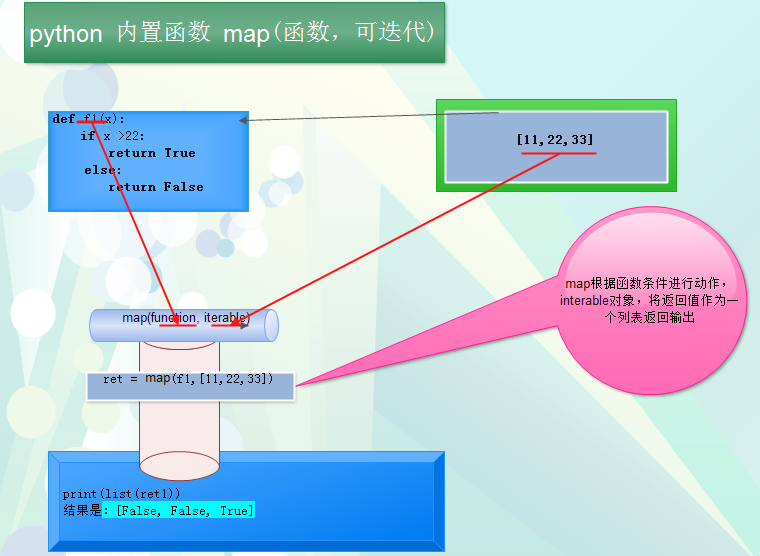
1 # map 实现 2 def mymap(fuc,seq): 3 n_li = [] 4 for i in seq: 5 n_i=fuc(i) 6 n_li.append(n_i) 7 # print(n_li) 8 return n_li 9 def f2(x): 10 return x+10 11 li = [11,22,33,44] 12 13 ret = mymap(f2,li) 14 print(ret)
1 def f1(x): 2 if x >22: 3 return True 4 else: 5 return False 6 ret1 = map(f1,[11,22,33,44]) 7 print(list(ret1)) 8 结果是:[False, False, True, True] 9 10 ret1 = map(lambda x:x+22,[11,22,33,44]) 11 print(list(ret1)) 12 结果是:[33, 44, 55, 66]
# format 格式化 字符串拼接+ 性能低
后面讲
# globals() 获取所有的全局变量
#local() #获取所有局部变量
# hash(对象) 获取对象hash 内存优化
返回对象的hash(哈希/散列)值(如果有的话)。hash值是整数。它被用于在字典查找时快速比较字典的键。相同的数值有相同的hash(尽管它们有不同的类型,比如1和1.0)。
# isinstance(对象,类)
上面有讲 判断对象是否是某个类创建的 父类的话也成立
# issubclass 是否是子类 后面讲
# iter 迭代器 后面讲
obj = iter([11,22,33,44]) ret = next(obj) print(ret)
# yield 生成器
后面讲
# max 最大 min
li = [11,22,33,44]
max(li)
# pow求次方
a= pow(2,10) print(a)
# repr() === ascii()
# round 四舍五入
round()方法返回 x 的小数点四舍五入到n个数字。
语法 以下是round()方法的语法: round( x [, n] ) 参数 x --这是一个数值表达式 n --这也是一个数值表达式 返回值 该方法返回 x 的小数点四舍五入到n个数字 例子 下面的例子显示了round()方法的使用 #!/usr/bin/python print "round(80.23456, 2) : ", round(80.23456, 2) print "round(100.000056, 3) : ", round(100.000056, 3) print "round(-100.000056, 3) : ", round(-100.000056, 3) 当我们运行上面的程序,它会产生以下结果: round(80.23456, 2) : 80.23 round(100.000056, 3) : 100.0 round(-100.000056, 3) : -100.0
# slice 对象切片
在python中,list, tuple以及字符串等可以遍历访问的类型都可以应用slice访问。slice本身的意思是指切片,在这些可以遍历访问的类型中截取其中的某些部分。
#sum 求和
sum(iterable[, start])
将start以及iterable的元素从左向右相加并返回总和。start默认为0。iterable的元素通常是数字,start值不允许是一个字符串。
对于某些使用场景,有比sum()更好的选择。连接字符串序列的首选和快速的方式是调用''.join(sequence)。如要相加扩展精度的浮点数,请参阅math.fsum()。若要连接一系列的可迭代量,可以考虑使用itertools.chain()。
其实sum()的参数是一个list 例如: sum([1,2,3]) sum(range(1,11)) 还有一个比较有意思的用法 a = range(1,11) b = range(1,10) c = sum([item for item in a if item in b]) print c 输出: 45
# supper 找到父类
super
(
type[, object-or-type])
返回一个代理对象,这个对象指派方法给一个父类或者同类. 这对进入类中被覆盖的继承方法非常有用。搜索顺序和 getattr() 一样。而它自己的 类型则被忽略
# vars 对象的变量个数
# zip 拉链 将两个列表合起来,做成一个列表,元素为数组
>>> a = range(5,10) >>> a [5, 6, 7, 8, 9] >>> b =(1,5) >>> b (1, 5) >>> b =range(1,5) >>> b [1, 2, 3, 4] >>> b.append(0) >>> b [1, 2, 3, 4, 0] >>> zip(a,b) [(5, 1), (6, 2), (7, 3), (8, 4), (9, 0)] >>> b.pop() 0 >>> b [1, 2, 3, 4] >>> a [5, 6, 7, 8, 9] >>> zip(a,b) [(5, 1), (6, 2), (7, 3), (8, 4)]
sort 函数
sorted(iterable[, cmp[, key[, reverse]]])
依据iterable中的元素返回一个新的列表。
可选参数cmp、key和reverse与list.sort()方法的参数含义相同(在可变的序列类型一节描述)。
cmp指定一个自定义的带有两个参数的比较函数(可迭代的元素),它应该根据第一个参数是小于、等于还是大于第二个参数返回负数、零或者正数:cmp=lambda x,y: cmp(x.lower(), y.lower())。默认值是None。
key指定一个带有一个参数的函数,它用于从每个列表元素选择一个比较的关键字:key=str.lower。默认值是None(直接比较元素)。
reverse是一个布尔值。如果设置为True,那么列表元素以反向比较排序。
通常情况下,key和reverse转换处理比指定一个等同的cmp函数要快得多。这是因为cmp为每个元素调用多次但是key和reverse只会触摸每个元素一次。使用functools.cmp_to_key()来转换旧式的cmp函数为key函数。
关于排序的实例和排序的简明教程,请参阅Sorting HowTo。
>>> sorted([5, 2, 3, 1, 4]) [1, 2, 3, 4, 5] >>> a = [5, 2, 3, 1, 4] >>> a.sort() >>> a [1, 2, 3, 4, 5] sorted 默认值对列表排序故字典只对key排序 >>> sorted({1: 'D', 2: 'B', 3: 'B', 4: 'E', 5: 'A'}) [1, 2, 3, 4, 5] key 函数 >>> sorted("This is a test string from Andrew".split(), key=str.lower) ['a', 'Andrew', 'from', 'is', 'string', 'test', 'This'] lambda >>> student_tuples = [ ('john', 'A', 15), ('jane', 'B', 12), ('dave', 'B', 10), ] >>> sorted(student_tuples, key=lambda student: student[2]) # sort by age [('dave', 'B', 10), ('jane', 'B', 12), ('john', 'A', 15)] The same technique works for objects with named attributes. For example: >>> class Student: def __init__(self, name, grade, age): self.name = name self.grade = grade self.age = age def __repr__(self): return repr((self.name, self.grade, self.age)) def weighted_grade(self): return 'CBA'.index(self.grade) / float(self.age) >>> student_objects = [ Student('john', 'A', 15), Student('jane', 'B', 12), Student('dave', 'B', 10), ] >>> sorted(student_objects, key=lambda student: student.age) # sort by age [('dave', 'B', 10), ('jane', 'B', 12), ('john', 'A', 15)] 更多详见 https://wiki.python.org/moin/HowTo/Sorting/
五 open() 函数 处理文件,单独拿出来讲解
open函数,该函数用于文件处理
操作文件时,一般需要经历如下步骤:
- 打开文件
- 操作文件
一、打开文件
文件句柄 = open('文件路径', '模式')
打开文件时,需要指定文件路径和以何等方式打开文件,打开后,即可获取该文件句柄,日后通过此文件句柄对该文件操作。
1 文件句柄 = open('文件路径','打开模式')
文件句柄相当于于变量名,文件路径可以写为绝对路径也可以写为相对路径。
文件句柄可以循环 每次1行
for line in 文件句柄:
文件句柄.write("新文件")
打开文件的模式有:
- r ,只读模式【默认】
- w,只写模式【不可读;不存在则创建;存在则清空内容;】
- x, 只写模式【不可读;不存在则创建,存在则报错】
- a, 追加模式【不可读; 不存在则创建;存在则只追加内容;】
"+" 表示可以同时读写某个文件
- r+, 读写【可读,可写】
- w+,写读【可读,可写】
- x+ ,写读【可读,可写】
- a+, 写读【可读,可写】
"b"表示以字节的方式操作
- rb 或 r+b
- wb 或 w+b
- xb 或 w+b
- ab 或 a+b
注:以b方式打开时,读取到的内容是字节类型,写入时也需要提供字节类型
文件 hello.txt Hello Word! 123 abc 456 abc 789 abc 刘建佐 代码 : f = open("hello.txt",'rb') # 用到b模式的时候 就不能跟 编码了。 data = f.read() f.close() print(data) 输出 C:\Python35\python3.exe E:/py_test/s5/open.py b'Hello Word!\r\n123\r\nabc\r\n456\r\nabc\r\n789\r\nabc\r\n\xe5\x88\x98\xe5\xbb\xba\xe4\xbd\x90'
python open函数 r 和rb区别

下面着重讲解下用"+" 同时读写某个文件的操作
# r+形式 写的时候在末尾追加,指针移到到最后
# 大家一定要清楚的明白读写的时候指针指向的位置,下面的这个例子一定要懂
# f.tell() 读取指针的位置
# f.seek(0) 设置指针的位置
with open('1.txt','r+',encoding='utf-8') as f:
print(f.tell()) #打印下 文件开始时候指针指向哪里 这里指向 0
print(f.read()) #读出文件内容'字符串',
print(f.tell()) #文件指针指到 9,一个汉子三个字符串,指针是以字符为单位
f.write('科比') #写入内容'科比',需要特别注意此时文件指到文件末尾去了
print(f.read()) #指针到末尾去了,所以读取的内容为空
print(f.tell()) #指针指到15
f.seek(0) #将指针内容指到 0 位置
print(f.read()) #因为文件指针指到开头去了,所以可以读到内容 字符串科比
# w+形式 存在的话先清空 一写的时候指针到最后
with open('1.txt','w+') as f:
f.write('Kg') #1.txt存在,所以将内面的内容清空,然后再写入 'kg'
print(f.tell()) #此时指针指向2
print(f.read()) #读不到内容,因为指针指向末尾了
f.seek(0)
print(f.read()) #读到内容,因为指针上一步已经恢复到起始位置
# a+打开的时候指针已经移到最后,写的时候不管怎样都往文件末尾追加,这里就不再演示了,读者可以自己试一下
# x+文件存在的话则报错,也不演示了
Python文件读取方式
| 模式 | 说明 |
| read([size]) | 读取文件全部内容,如果设置了size,那么就读取size字节 |
| readline([size]) | 一行一行的读取 |
| readlines() | 读取到的每一行内容作为列表中的一个元素 |
二、操作

class file(object) def close(self): # real signature unknown; restored from __doc__ 关闭文件 """ close() -> None or (perhaps) an integer. Close the file. Sets data attribute .closed to True. A closed file cannot be used for further I/O operations. close() may be called more than once without error. Some kinds of file objects (for example, opened by popen()) may return an exit status upon closing. """ def fileno(self): # real signature unknown; restored from __doc__ 文件描述符 """ fileno() -> integer "file descriptor". This is needed for lower-level file interfaces, such os.read(). """ return 0 def flush(self): # real signature unknown; restored from __doc__ 刷新文件内部缓冲区 """ flush() -> None. Flush the internal I/O buffer. """ pass def isatty(self): # real signature unknown; restored from __doc__ 判断文件是否是同意tty设备 """ isatty() -> true or false. True if the file is connected to a tty device. """ return False def next(self): # real signature unknown; restored from __doc__ 获取下一行数据,不存在,则报错 """ x.next() -> the next value, or raise StopIteration """ pass def read(self, size=None): # real signature unknown; restored from __doc__ 读取指定字节数据 """ read([size]) -> read at most size bytes, returned as a string. If the size argument is negative or omitted, read until EOF is reached. Notice that when in non-blocking mode, less data than what was requested may be returned, even if no size parameter was given. """ pass def readinto(self): # real signature unknown; restored from __doc__ 读取到缓冲区,不要用,将被遗弃 """ readinto() -> Undocumented. Don't use this; it may go away. """ pass def readline(self, size=None): # real signature unknown; restored from __doc__ 仅读取一行数据 """ readline([size]) -> next line from the file, as a string. Retain newline. A non-negative size argument limits the maximum number of bytes to return (an incomplete line may be returned then). Return an empty string at EOF. """ pass def readlines(self, size=None): # real signature unknown; restored from __doc__ 读取所有数据,并根据换行保存值列表 """ readlines([size]) -> list of strings, each a line from the file. Call readline() repeatedly and return a list of the lines so read. The optional size argument, if given, is an approximate bound on the total number of bytes in the lines returned. """ return [] def seek(self, offset, whence=None): # real signature unknown; restored from __doc__ 指定文件中指针位置 """ seek(offset[, whence]) -> None. Move to new file position. Argument offset is a byte count. Optional argument whence defaults to (offset from start of file, offset should be >= 0); other values are 1 (move relative to current position, positive or negative), and 2 (move relative to end of file, usually negative, although many platforms allow seeking beyond the end of a file). If the file is opened in text mode, only offsets returned by tell() are legal. Use of other offsets causes undefined behavior. Note that not all file objects are seekable. """ pass def tell(self): # real signature unknown; restored from __doc__ 获取当前指针位置 """ tell() -> current file position, an integer (may be a long integer). """ pass def truncate(self, size=None): # real signature unknown; restored from __doc__ 截断数据,仅保留指定之前数据 """ truncate([size]) -> None. Truncate the file to at most size bytes. Size defaults to the current file position, as returned by tell(). """ pass def write(self, p_str): # real signature unknown; restored from __doc__ 写内容 """ write(str) -> None. Write string str to file. Note that due to buffering, flush() or close() may be needed before the file on disk reflects the data written. """ pass def writelines(self, sequence_of_strings): # real signature unknown; restored from __doc__ 将一个字符串列表写入文件 """ writelines(sequence_of_strings) -> None. Write the strings to the file. Note that newlines are not added. The sequence can be any iterable object producing strings. This is equivalent to calling write() for each string. """ pass def xreadlines(self): # real signature unknown; restored from __doc__ 可用于逐行读取文件,非全部 """ xreadlines() -> returns self. For backward compatibility. File objects now include the performance optimizations previously implemented in the xreadlines module. """ pass 2.x

1 class TextIOWrapper(_TextIOBase): 2 """ 3 Character and line based layer over a BufferedIOBase object, buffer. 4 5 encoding gives the name of the encoding that the stream will be 6 decoded or encoded with. It defaults to locale.getpreferredencoding(False). 7 8 errors determines the strictness of encoding and decoding (see 9 help(codecs.Codec) or the documentation for codecs.register) and 10 defaults to "strict". 11 12 newline controls how line endings are handled. It can be None, '', 13 '\n', '\r', and '\r\n'. It works as follows: 14 15 * On input, if newline is None, universal newlines mode is 16 enabled. Lines in the input can end in '\n', '\r', or '\r\n', and 17 these are translated into '\n' before being returned to the 18 caller. If it is '', universal newline mode is enabled, but line 19 endings are returned to the caller untranslated. If it has any of 20 the other legal values, input lines are only terminated by the given 21 string, and the line ending is returned to the caller untranslated. 22 23 * On output, if newline is None, any '\n' characters written are 24 translated to the system default line separator, os.linesep. If 25 newline is '' or '\n', no translation takes place. If newline is any 26 of the other legal values, any '\n' characters written are translated 27 to the given string. 28 29 If line_buffering is True, a call to flush is implied when a call to 30 write contains a newline character. 31 """ 32 def close(self, *args, **kwargs): # real signature unknown 33 关闭文件 34 pass 35 36 def fileno(self, *args, **kwargs): # real signature unknown 37 文件描述符 38 pass 39 40 def flush(self, *args, **kwargs): # real signature unknown 41 刷新文件内部缓冲区 42 pass 43 44 def isatty(self, *args, **kwargs): # real signature unknown 45 判断文件是否是同意tty设备 46 pass 47 48 def read(self, *args, **kwargs): # real signature unknown 49 读取指定字节数据 50 pass 51 52 def readable(self, *args, **kwargs): # real signature unknown 53 是否可读 54 pass 55 56 def readline(self, *args, **kwargs): # real signature unknown 57 仅读取一行数据 58 pass 59 60 def seek(self, *args, **kwargs): # real signature unknown 61 指定文件中指针位置 62 pass 63 64 def seekable(self, *args, **kwargs): # real signature unknown 65 指针是否可操作 66 pass 67 68 def tell(self, *args, **kwargs): # real signature unknown 69 获取指针位置 70 pass 71 72 def truncate(self, *args, **kwargs): # real signature unknown 73 截断数据,仅保留指定之前数据 74 pass 75 76 def writable(self, *args, **kwargs): # real signature unknown 77 是否可写 78 pass 79 80 def write(self, *args, **kwargs): # real signature unknown 81 写内容 82 pass 83 84 def __getstate__(self, *args, **kwargs): # real signature unknown 85 pass 86 87 def __init__(self, *args, **kwargs): # real signature unknown 88 pass 89 90 @staticmethod # known case of __new__ 91 def __new__(*args, **kwargs): # real signature unknown 92 """ Create and return a new object. See help(type) for accurate signature. """ 93 pass 94 95 def __next__(self, *args, **kwargs): # real signature unknown 96 """ Implement next(self). """ 97 pass 98 99 def __repr__(self, *args, **kwargs): # real signature unknown 100 """ Return repr(self). """ 101 pass 102 103 buffer = property(lambda self: object(), lambda self, v: None, lambda self: None) # default 104 105 closed = property(lambda self: object(), lambda self, v: None, lambda self: None) # default 106 107 encoding = property(lambda self: object(), lambda self, v: None, lambda self: None) # default 108 109 errors = property(lambda self: object(), lambda self, v: None, lambda self: None) # default 110 111 line_buffering = property(lambda self: object(), lambda self, v: None, lambda self: None) # default 112 113 name = property(lambda self: object(), lambda self, v: None, lambda self: None) # default 114 115 newlines = property(lambda self: object(), lambda self, v: None, lambda self: None) # default 116 117 _CHUNK_SIZE = property(lambda self: object(), lambda self, v: None, lambda self: None) # default 118 119 _finalizing = property(lambda self: object(), lambda self, v: None, lambda self: None) # default 120 121 3.x
操作示例:
测试的文件名是 "hello.txt" ,文件内容为:
Hello Word! 123 abc 456 abc 789 abc
read 方法
代码:
# 以只读的方式打开文件hello.txt f = open("hello.txt","r") # 读取文件内容赋值给变量c c = f.read() # 关闭文件 f.close() # 输出c的值 print(c)
输出结果
C:\Python35\python3.exe E:/py_test/s5/open.py
Hello Word!
123
abc
456
abc
789
abc
readline
代码:
# 以只读模式打开文件hello.txt f = open("hello.txt","r") # 读取第一行 strip 去除空行 c1 = f.readline().strip() # 读取第二行 c2 = f.readline().strip() # 读取第三行 c3 = f.readline().strip() # 关闭文件 f.close() # 输出读取文件第一行内容 print(c1) # 输出读取文件第二行内容 print(c2) # 输出读取文件第三行内容 print(c3)
C:\Python35\python.exe F:/Python_code/sublime/Day06/file.py
Hello Word!
123
abc
readlines 获取到的是列表,每行是列表的元素
用法
# 以只读的方式打开文件hello.txt f = open("hello.txt","r") # 将文件所有内容赋值给c c = f.readlines() # 查看数据类型 print(type(c)) # 关闭文件 f.close() # 遍历输出文件内容 # n.strip()去除空行 for n in c: print(n.strip())
Python文件写入方式
| 方法 | 说明 |
| write(str) | 将字符串写入文件 ,原文件内容存在则清空,不存在新建 |
| writelines(sequence or strings) | 写多行到文件,参数可以是一个可迭代的对象,列表、元组等 |
write
代码:
# 以只读的模式打开文件write.txt,没有则创建,有则覆盖内容 file = open("write.txt","w") # 在文件内容中写入字符串test write file.write("test write") # 关闭文件 file.close()
writeline
代码:
# 以只读模式打开一个不存在的文件wr_lines.txt f = open("wr_lines.txt","w",encoding="utf-8") # 写入一个列表 f.writelines(["11","22","33"]) # 关闭文件 f.close()
wr_lines.txt 文件内容:
112233
Python文件操作所提供的方法
close(self):
关闭已经打开的文件
f.close()
fileno(self):
文件描述符
f = open("hello.txt",'rb') data = f.fileno() f.close() print(data)
输出结果
C:\Python35\python3.exe E:/py_test/s5/open.py
3
flush(self):
刷新缓冲区的内容到硬盘中
f.flush() #在r+ 或者 rb+模式下还没有 f.close() 或者之后,flush方法 就会将内存的数据写入硬盘。 否则在其他地方调用这个文件的新内容会找不到
isatty(self):
判断文件是否是tty设备,如果是tty设备则返回 True ,否则返回 False
f = open("hello.txt","r") ret = f.isatty() f.close() print(ret)
返回结果:
C:\Python35\python.exe F:/Python_code/sublime/Day06/file.py
False
readable(self):
是否可读,如果可读返回 True ,否则返回 False
f = open("hello.txt","r") ret = f.readable() f.close() print(ret)
返回结果:
C:\Python35\python.exe F:/Python_code/sublime/Day06/file.py
True
readline(self, limit=1):
每次仅读取一行数据
f = open("hello.txt","r") print(f.readline()) print(f.readline()) f.close()
返回结果:
C:\Python35\python.exe F:/Python_code/sublime/Day06/file.py
Hello Word!
123
readlines(self, hint=1):
把每一行内容当作列表中的一个元素
f = open("hello.txt","r") print(f.readlines()) f.close()
返回结果:
C:\Python35\python.exe F:/Python_code/sublime/Day06/file.py ['Hello Word!\n', '123\n', 'abc\n', '456\n', 'abc\n', '789\n', 'ab c']
tell(self):
获取指针位置
f = open("hello.txt","r") print(f.tell()) f.close()
返回结果:
C:\Python35\python.exe F:/Python_code/sublime/Day06/file.py
0
seek(self, offset, whence=io.SEEK_SET):
指定文件中指针位置
f = open("hello.txt","r") print(f.tell()) f.seek(3) print(f.tell()) f.close()
执行结果
C:\Python35\python.exe F:/Python_code/sublime/Day06/file.py
0 3
seekable(self):
指针是否可操作
f = open("hello.txt","r") print(f.seekable()) f.close()
执行结果
C:\Python35\python.exe F:/Python_code/sublime/Day06/file.py
True
writable(self):
是否可写
f = open("hello.txt","r") print(f.writable()) f.close()
执行结果
C:\Python35\python.exe F:/Python_code/sublime/Day06/file.py
False
writelines(self, lines):
写入文件的字符串序列,序列可以是任何迭代的对象字符串生产,通常是一个 字符串列表 。
f = open("wr_lines.txt","w") f.writelines(["11","22","33"]) f.close()
执行结果
112233
read(self, n=None):
读取指定字节数据,后面不加参数默认读取全部
f = open("wr_lines.txt","r") print(f.read(3)) f.seek(0) print(f.read()) f.close()
执行结果
C:\Python35\python.exe F:/Python_code/sublime/Day06/file.py
112
112233
write(self, s):
往文件里面写内容
f = open("wr_lines.txt","w") f.write("abcabcabc") f.close()
文件内容
abcabcabc
练习题: 2版本 操作 文件内容替换

文件内容的替换 fileinput.input 注意 1 改文件内容 有inplace=1 没有inplace=1 原始文件不会被修改。不写的话默认=0 输出显示改掉,文件不该掉 2 、最后改完print 最后必须print 一下。不然会全部清空 查看源文件 root@python:/home/liujianzuo/py_training/seminar6/day2# cat filehandle1.py #!/usr/bin/env python f = file('syslog') #for line in f.xreadlines(): # print line, # print break while True: line = f.readlines() print line, if not line:break root@python:/home/liujianzuo/py_training/seminar6/day2# python Python 2.7.6 (default, Mar 22 2014, 22:59:56) [GCC 4.8.2] on linux2 Type "help", "copyright", "credits" or "license" for more information. >>> import tab >>> import fileinput >>> import fileinput,tab >>> for line in fileinput.input('filehandle1.py',inplace=1): ... line = line.replace('break','continue') # 注意tab或者空格换行 ... print line, ... ##直接回车 操作完查看 root@python:/home/liujianzuo/py_training/seminar6/day2# cat filehandle1.py.bak #!/usr/bin/env python f = file('syslog') #for line in f.xreadlines(): # print line, # print continue while True: line = f.readlines() print line, if not line:continue 2.1 课上 新的替换问价内容的方法 root@python-10:~# cd /home/liujianzuo/python/day2/ root@python-10:/home/liujianzuo/python/day2# ls chinese.py ex2.py __init__.py py_home_work.csv second.pyc ex1.py ex3_file_io.py __init__.pyc second.py test root@python-10:/home/liujianzuo/python/day2# cp /etc/passwd . #!/usr/bin/env python import sys if '-r' in sys.argv: #判断 输入的 -r 是在参数位置 rep_argv_pos = sys.argv.index('-r') #赋值-r 索引位置 find_str = sys.argv[rep_argv_pos + 1] new_str = sys.argv[rep_argv_pos + 2] f = file('passwd','r+') while True: line = f.readline() print "===>",f.tell() if find_str in line: print '---> cur pos',f.tell(),len(line) last_line_pos=f.tell() - len(line) f.seek(last_line_pos) print '----> new pos',f.tell() new_line= line.replace(find_str,new_str) f.write(new_line) break f.close() root@python-10:/home/liujianzuo/python/day2# py replace_new.py -r root ROOT ===> 32 ---> cur pos 32 32 ----> new pos 0 root@python-10:/home/liujianzuo/python/day2# head -1 passwd ROOT:x:0:0:ROOT:/ROOT:/bin/bash 3 更改文件内容前备份 backup=‘。Bak’ >>> help(fileinput) class FileInput | FileInput([files[, inplace[, backup[, bufsize[, mode[, openhook]]]]]]) | | Class FileInput is the implementation of the module; its methods | filename(), lineno(), fileline(), isfirstline(), isstdin(), fileno(), | nextfile() and close() correspond to the functions of the same name | in the module. | In addition it has a readline() method which returns the next | input line, and a __getitem__() method which implements the | sequence behavior. The sequence must be accessed in strictly | sequential order; random access and readline() cannot be mixed. | | Methods defined here: | | __del__(self) | | __getitem__(self, i) | | __init__(self, files=None, inplace=0, backup='', bufsize=0, mode='r', openhook=None) 操作: 最后不带print >>> for line in fileinput.input('filehandle1.py',inplace=1,backup='.bak'): ... line = line.replace('continue','break') ... >>> root@python:/home/liujianzuo/py_training/seminar6/day2# ls filehandle1.py filehandle1.py.bak filehandle.py syslog test.txt zh-CN.zip root@python:/home/liujianzuo/py_training/seminar6/day2# cat filehandle1.py #内容被清除掉了 我们将备份恢复进行再次备份操作 root@python:/home/liujianzuo/py_training/seminar6/day2# cp filehandle1.py.bak filehandle1.py root@python:/home/liujianzuo/py_training/seminar6/day2# cat filehandle1.py #!/usr/bin/env python f = file('syslog') #for line in f.xreadlines(): # print line, # print continue while True: line = f.readlines() print line, if not line:continue 再次执行 >>> for line in fileinput.input('filehandle1.py',inplace=1,backup='.bak1'): ... line = line.replace('continue','TERWTREW') ... print line, ... 再次检查 root@python:/home/liujianzuo/py_training/seminar6/day2# ls filehandle1.py filehandle1.py.bak filehandle1.py.bak1 filehandle.py syslog test.txt zh-CN.zip root@python:/home/liujianzuo/py_training/seminar6/day2# cat filehandle1.py #!/usr/bin/env python f = file('syslog') #for line in f.xreadlines(): # print line, # print TERWTREW while True: line = f.readlines() print line, if not line:TERWTREW
三、管理上下文
为了避免打开文件后忘记关闭,可以通过管理上下文,即:
1 with open('log','r') as f: 2 3 ...
如此方式,当with代码块执行完毕时,内部会自动关闭并释放文件资源。
在Python 2.7 及以后,with又支持同时对多个文件的上下文进行管理,即:
1 with open('log1') as obj1, open('log2') as obj2: 2 pass
1 # 文件句柄可以循环,每次1句,写入 另一个文件 2 with open('hello.txt','r') as obj1 ,open('log2','w') as obj2: 3 for line in obj1: 4 obj2.write(line)
open fileinput 练习 更改文本内容 增删改查用户 以及注册登陆
1 #!/usr/bin/env python 2 # _*_ coding:utf-8 _*_ 3 __author__ = 'liujianzuo' 4 5 6 def login(username,password): 7 """ 8 用户验证 9 :param username: 用户名 10 :param password: 密码 11 :return: true 成功 false 失败 12 """ 13 f = open("db",'r') 14 for line in f: 15 line=line.strip() 16 line=line.split(":") 17 if username == line[0] and password == line[1]: 18 return True 19 return False 20 21 def register(temp): 22 """ 23 注册写入 24 :param temp: 写入的用户名密码 25 :return: true是注册成功 26 """ 27 with open('db','a+',encoding='utf-8') as f: 28 f.write(temp) 29 return True 30 def user_exist(username): 31 """ 32 判断用户存在并调用注册 33 :param username: 34 :return: true 是注册成功 false 是用户存在 35 """ 36 with open('db','r',encoding='utf-8') as f: 37 for line in f: 38 if username == line.strip().split(':')[0]: 39 #print("exist") 40 return False 41 else: 42 pwd = input("pls input pwd:") 43 temp = "\n"+username+":"+pwd 44 a = register(temp) 45 if a: 46 #print("register success") 47 return True 48 49 def changepwd(): 50 """ 51 改密码 52 :return: True 改成功了 False 用户不存在 53 """ 54 # import fileinput 55 # username = input("input ur username:") 56 # f = open('db','r+',) 57 # #print(type(username)) 58 # for line in f: 59 # line = line.strip().split(':') 60 # #print(type(line[1])) 61 # #line[1] = str(line[1]) 62 # if line[0] == username: 63 # pwd = input("chage ur 原来的 passwd:") 64 # if line[1] != pwd: 65 # print("not creect") 66 # return "原密码不对" 67 # f.close() 68 # 69 # new_pwd = input('chage ur new pwd:') 70 # # print(username+":"+new_pwd) 71 # # exit() 72 # for n in fileinput.input('db',inplace=1): 73 # #x = n.strip().split(':') 74 # n = n.replace(username+":"+pwd,username+":"+new_pwd).strip() 75 # print(n) 76 # return True 77 f = open('db','r') 78 data = f.readlines() 79 f.close() 80 username = input("pls input username:") 81 #print(data) 82 for i in range(len(data)): 83 if username == data[i].split(":")[0]: 84 pwd = input("input new passwd:") 85 data[i] = username+":"+pwd+"\n" 86 n = open('db','w+') 87 n.writelines(data) 88 return True 89 90 def dele(): 91 """ 92 删除用户 93 :return: 94 """ 95 f = open('db','r') 96 data = f.readlines() 97 f.close() 98 username = input("pls input username:") 99 #print(data) 100 for i in range(len(data)): 101 if username == data[i].split(":")[0]: 102 #pwd = input("input new passwd:") 103 del data[i] 104 n = open('db','w+') 105 n.writelines(data) 106 return True 107 108 def chs(chose): 109 """ 110 选择菜单 111 :param chose: 112 :return: 113 """ 114 if chose == 1: 115 user = input("pls input username:") 116 pwd = input("pls input password:") 117 118 ret = login(user,pwd) 119 if ret: 120 print("登陆成功") 121 else: 122 print("登陆失败") 123 elif chose == 2: 124 user = input("register name:") 125 n = user_exist(user) 126 if n: 127 print("regist success") 128 else: 129 print("usernaem exist") 130 elif chose == 3: 131 ret = changepwd() 132 if ret: 133 print("修改成功") 134 135 elif chose == 4: 136 ret = dele() 137 if ret: 138 print("删除成功") 139 140 else: 141 print("chose not correct") 142 def confirm(chose): 143 """ 144 判断输入 145 :param chose: 146 :return: 147 """ 148 while True: 149 if len(chose) == 0: 150 print("\033[31;1mnot empty!!!!\033[0m") 151 chose = input("\033[35;1mpls input ur chose ,quit for leave:\033[0m") 152 continue 153 elif chose == 'quit': 154 return True 155 elif chose.isdigit() != True: 156 print("\033[31;1minput digit!!!!\033[0m") 157 chose = input("\033[35;1mpls input ur chose ,quit for leave:\033[0m") 158 continue 159 else: 160 break 161 162 def main(): 163 print("""\033[32;1m 164 1 login 165 2 register 166 3 忘记密码 167 4 删除用户 168 \033[0m""") 169 chose = input("\033[35;1mpls input ur chose ,quit for leave:\033[0m") 170 ret = confirm(chose) 171 if ret: 172 print("will quit") 173 return ret 174 chose=int(chose) 175 chs(chose) 176 177 if __name__ == "__main__": 178 main()


